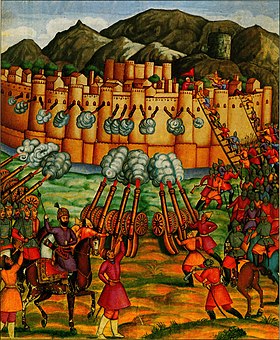Siege of Kandahar
| Siege of Kandahar | |||||||||
|---|---|---|---|---|---|---|---|---|---|
| Part of Qandahar Campaign of 1737 | |||||||||
 Illustration of the siege of Kandahar | |||||||||
| |||||||||
| Belligerents | |||||||||
|
Afsharid Persia |
Hotaki dynasty | ||||||||
| Commanders and leaders | |||||||||
|
Hussain Hotaki (POW ) | ||||||||
| Casualties and losses | |||||||||
| Unknown |
All killed or captured Fall of the Safavids ]
Afghan Campaigns
Rebellions & Civil War
| ||||||||
The siege of Kandahar began when
Background
After expelling the Afghans from Iran in 1729, Tahmasp Qoli Khan had planned to attack the Hotaks and reconquer Qandahar in 1730. However, multiple events postponed this. As Hussain Hotak was afraid of an Afsharid attack on Qandahar he incited the Abdalis of Herat to revolt,[3] causing Nader to abandon his campaign against the Ottomans and incorporate Herat back into the Safavid Empire. This was done with the Fall of Herat on February 27, 1732.[4][5][3] When Nader made peace with the Ottomans in 1736, he began to prepare to attack.
The siege
Much of the duration of the siege saw little fighting as Nader's forces' lack of heavy artillery forced them to settle into a blockade of the fortified town.
Bakhtiari assault


In anticipation of the siege, the Afghans had stockpiled large amounts of provisions in the fortified town and although starvation had begun to take hold by the end of 1737, Nader realized that it would take a long time for the Afghans to exhaust the last of their provisions. He was unsure of his position in Persia; although he had deposed
Nader initially tried to dissuade the
The Afghans made several attempts to retake the city's fortifications but they were beaten back by heavy fire from the Bakhtiari Jazayerchis. Realizing the hopelessness of the struggle,
Aftermath
Nader Shah generously rewarded the Bakhtiaris and personally rewarded Adineh Mostafi with a bag full of gold.
The city of Kandahar was systematically destroyed by artillery fire and the surviving inhabitants were transferred to a new city that the Afsharid forces had prepared and planned to build about 6 miles south-east of the ancient city.[6] Nader named the city "Naderabad", after himself. The old city was not reoccupied but the ruins of the old Kandahar Citadel remain visible to this day. The capture of Kandahar is a resonant event in Bakhtiari Oral history and in Lur culture in general; it is an event which has become a cultural touchstone.[10]
See also
- Military of the Afsharid dynasty of Persia
- Durrani dynasty
References
- ^ Afghanistan at War: From the 18th-Century Durrani Dynasty to the 21st Century "He was able to take Kandahar in 1738, ending the Hotak dynasty"
- ^ a b c d e f g Axworthy p.185
- ^ a b Nejatie, Sajjad (November 2017). The Pearl of Pearls: The Abdālī-Durrānī Confederacy and Its Transformation under Aḥmad Shāh, Durr-i Durrān (Thesis thesis).
- ISBN 978-0-521-20095-0.
- ISBN 978-1-84511-982-9.
- ^ a b c d Axworthy p.182
- ^ Axworthy p.183
- ^ Axworthy p.187
- )
- )
Sources
- ISBN 1-85043-706-8
